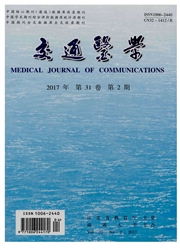

 中文摘要:
中文摘要:
目的:探讨14种脊椎动物中成纤维细胞生长因子家族(fibroblast growth factors,FGFs)的特异性受体家族成纤维细胞生长因子受体(fibroblast growth factor receptors,FGFRs)蛋白的分子进化模型,并对其蛋白质结构和功能进行初步的分析。方法:基于最大似然法,综合运用NCBI、Inter Pro等在线生物信息数据库和Linux生物信息分析平台,对14种处于不同进化地位的脊椎动物的FGFRs进行系统进化分析。结果:构建了14种脊椎动物FGFR1、FGFR2、FGFR3、FGFR4的系统进化树,分析了氨基酸含量分布模式、蛋白序列平均疏水值和保守蛋白序列的结构域分布模式。结论:14种脊椎动物FGFRs的系统进化分歧跟各个物种的种属进化基本相适应,但又有其个性化的特征,它们的分子和物理特点体现了结构与功能相适应的普遍原则。
 英文摘要:
英文摘要:
Objective: To discuss protein molecular evolution model of fibroblast growth factor receptors(FGFRs) in 14 kinds of vertebrates,and carried on the preliminary analysis of their protein structures and functions. Methods: On the bases of maximum likelihood method,the data identified from NCBI,Inter Pro databases and Linux were analyzed by phylogenetic trees to shed light on the FGFRs evolution in the 14 species of vertebrates. Results: Phylogenetic trees of FGFR1,FGFR2,FGFR3 and FGFR4 were constructed,and patterns of amino acids distribution,mean hydrophobicity and highly conserved sequences in FGFRs were also analyzed. Conclusion: The evolution of FGFRs in 14 species of vertebrates is consistent with those of the species,but also with distinct characteristics. Their molecular and physical characteristics reflected the common principle that structures and functions adapt reciprocally.
 同期刊论文项目
同期刊论文项目
 同项目期刊论文
同项目期刊论文
 Downregulation of Pax3 expression correlates with acquired GFAP expression during NSC differentiatio
Downregulation of Pax3 expression correlates with acquired GFAP expression during NSC differentiatio Involvement of gecko SNAP25b in spinal cord regeneration by promoting outgrowth and elongation of ne
Involvement of gecko SNAP25b in spinal cord regeneration by promoting outgrowth and elongation of ne HMGB1 Protein Does Not Mediate the Inflammatory Response in Spontaneous Spinal Cord Regeneration A H
HMGB1 Protein Does Not Mediate the Inflammatory Response in Spontaneous Spinal Cord Regeneration A H Basic fibroblast growth factor is a key factor that induces bone marrow mesenchymal stem cells towar
Basic fibroblast growth factor is a key factor that induces bone marrow mesenchymal stem cells towar 期刊信息
期刊信息
